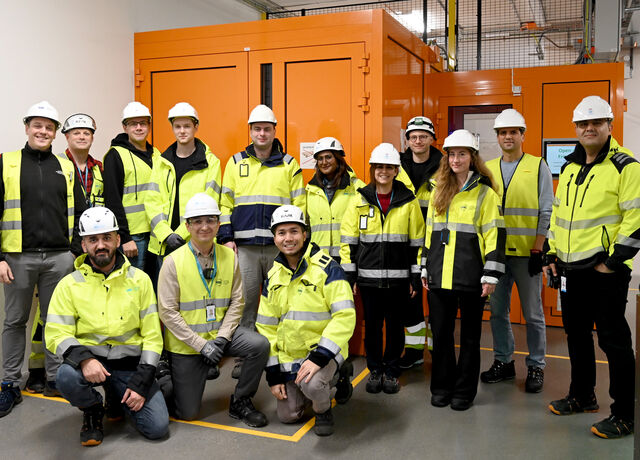Beam Physics & Beam Diagnostics
The Beam Physics section studies dynamics of the proton beam in the ESS linac to achieve a linac design allowing high performance and reliable operation as well as to prepare for the future commissioning and operation of the linac.
The beam physics and operations work package, of which the beam physics section is in charge, is the "integrator” of the ESS accelerator project and becomes the "driver" of the accelerator during the commissioning.
While components of the ESS accelerator are designed and produced by other work packages, this work package integrates these components and evaluates them as one system in the scope of ensuring performance and reliability of the accelerator.
The task of this work package also includes preparations and executions of adjustments of the accelerator parameters during commissioning and operation, including developments of high level physics applications used in the control room, again to ensure the performance and reliability of the accelerator.
The Beam Diagnostics section is responsible for the development of all the beam instrumentation in the ESS linac, all the way from the source up until the beam spot on the target.
The Beam Diagnostics work package includes the development of all beam instrumentation for the ESS linac.
Beam instrumentation will provide detailed information on the condition and location of the proton beam. Such information is critical for the commissioning and for the safe and reliable operation of the ESS linear accelerator (linac).
The instrumentation that will be deployed:
The BLM system is arguably the most important diagnostic system of the ESS linac. It has the dual purpose of keeping the machine safe from beam-induced damage and avoiding excessive machine activation by providing critical input to the MPS. Thus, the system must be designed to not have any blind spots. In addition, as the BLM system is a major tool for beam tune-up, it should also be designed in a way that enables it to pinpoint the loss location as precisely as possible.
The BCM system measures the beam current versus time at various locations along the linac. BCM systems address concerns of damaging beam loss that the BLM cannot easily detect. The accelerator-to-target (A2T) and dump sections also contain BCMs. BCMs provide the beam current waveform over the macro pulse, the charge per pulse, the average beam current, and the cumulative charge. In addition to the absolute current, some of the BCMs are be configured for a differential current measurement. The BCMs are connected to the machine protection system so that the beam can be shut off if the absolute or the differential current exceeds user-defined thresholds.
The BPM system is used to measure the beam position, the beam phase and an approximate beam current. The BPM data is used to correct the beam trajectory during machine commissioning and normal operation. The BPM system provides the horizontal and the vertical beam position waveform throughout the macro pulse as well as the beam position averaged during the pulse. In addition, differential phase measurements are used for energy calculations based on time-of-flight between two BPMs. The BPM system provides the phase waveform throughout the macro pulse and the phase averaged over the pulse.
During commissioning and tuning of the ESS linac, insertable Faraday cups measure beam current while isolating the downstream accelerator components from beam. The acquisition electronics measures current ranging from 5 mA to 50 mA. To avoid overheating, the beam must be in the diagnostics mode when any Faraday cups are inserted.
Because they have been deployed successfully at several similar facilities, wire scanners represent a conservative choice for the measurement of transverse beam profiles. They employ a thin wire that scans transversely across the beam. During the scan, the electronics simultaneously acquire the position of the wire and the signal due to the beam-wire interaction. Signal processing and analysis software then reconstructs the beam profile. When the wires are in use, beam is limited to the diagnostics mode due to wire heating and beam loss. As with all insertable devices, an MPS interface is required to protect against device damage.
Two types of NPM systems are used: ionisation profile monitors (IPM) and luminescence profile monitors (LPM). These methods could allow measurements of the beam profile during neutron production, since they would not require the use of shorter diagnostics pulses. However, they are often viewed as less exact than wire scanners and may have limited resolution at low beam powers, so invasive devices are retained for cross calibration even where the non-invasive devices are installed.
The beam emittance is the six-dimensional distribution of all position coordinates along the three configuration space directions and the associated velocity coordinates. Two types of EMU systems are used: Allison emittance scanner in the LEBT and slit and grid emittance system in the MEBT. An Allison scanner consists of a front slit, deflecting plates, a rear slit, and a Faraday cup in a single unit that is stepped across the beam with a stepper motor. At each stepper position, the beamlet selected by the front slit is swept across the rear slit with the deflecting plates and the transmitted current measured as a function of deflecting plate voltage by the Faraday cup. For slit and grid operation at each slit position, the narrow aperture allows the passage of a beamlet populated by particles that have approximately the same position x and a certain angular distribution. Due to the phase space rotation in the following drift space, the beamlet’s angular distribution is transformed into a position distribution and sampled using a profile monitor, in this case a wire grid.
Longitudinal matching needs to be measured and improved wherever the focusing structure of the linac changes. Four bunch length monitors are required at each interface between different linac sections, for this purpose. A bunch shape monitor seems to be the best option. Such a detector is based on measuring secondary electrons from a wire placed in the tail of the beam distribution. Since the process of electron emission does not have a significant delay, very good time resolution can in principle be achieved. Due to different beam properties at certain points in linac, the BSM systems differ in design and the method used to obtain the longitudinal beam shape.
The supporting electronics for each instrumentation device contains several interfaces such as timing, RF reference, control system network, machine protect system (MPS), power and the instrumentation device in or on the beam line. The timing system synchronizes all acquisition of beam-based signals, tagging data with the global time stamp. For data associated with a given beam pulse, the time stamp allows unique identification of that pulse. A few systems (BPM, BSM) are synchronized to the RF structure and require an interface to the RF reference distribution system. In an Experimental Physics and Industrial Controls (EPICS) control system, the collection of process variables defines the system’s interface to the network. Timing events trigger the update of EPICS process variables containing beam data.




























